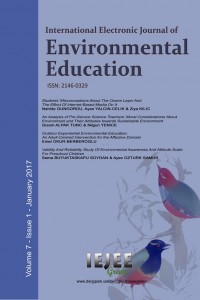Abstract
The aim of this study is to conduct a validity and reliability study of the Environmental Awareness and Attitude Scale for Preschool Children (EAASPC). For this purpose, the EAASPC consisitng of 26 items was developed by the authors. Views of experts were sought regarding the items and pictures of the scale, and after making necessary adjustments a pilot study was conducted by the authors with a group of 50 children. As the items and the scale were found to be suitable, the EAASPC was administered to 310 children. Analysis of the data was perforrmed using an SPSS statistics program. In order to measure the validity of the scale, factor analysis was performed and the correlation coefficients between the subscales was determined. For reliability analysis, Cronbach’s alpha and Spearman Brown calculations were conducted. Moreover, for item discrimination the total scores of the upper and lower 27 % of the sample were used. At the end of the analyses, the scale was finalized with 26 items. Descriptive factor analysis results support the findings that the scale is composed of two subscales. In the Environmental Attitudes subscale, 3 factors that explain 40.94% of the total variance were found. Factor loadings of the items in the Environmental Attitudes subscale varied between 0.42 and 0.74 and in the Environmental Awareness subscale factor loadings varied between 0.39 and 0.74. The correlation coefficients between the factors of the Environmental Awareness subscale were r =.80, .78 and .83 and for the Environmental Attitudes subscale were r =.70, .79 and .72 respectively. In statistics done for the reliability study of the Environmental Attitudes subscale, the Spearman Brown reliability coefficient was found to be 0.75, and the Cronbach’s alpha reliability coefficient was found to be 0.73. For the Environmental Awareness subscale these coefficents were found to be .65 and .65 respectively. For the whole EAASPC scale the Spearman Brown reliability coefficient was found to be 0,60, while the Cronbach’s alpha reliability coefficient was found to be 0.67. According to t-test results concerning the significance of the difference between the upper and lower 27% of the total scores, there is a significant difference in favour of the upper group. The item discrimination power of the SAAPC scale for the first factor (Environmetal Attitudes) varies between 0.34 and 0.47, for the second factor (Environmetal Awareness) it varies between 0.32 and 0.40. The scale’s average item discrimination power is 38. This value indicates that the scale has a discrimination feature. According to study results a scale composed of 26 items with two subscales was formed and the scale can be claimed to be a valid and reliable instrument for preschool children.
Details
| Journal Section | Research Papers |
|---|---|
| Authors | |
| Publication Date | January 31, 2017 |
| Published in Issue | Year 2017 Volume: 7 Issue: 1 |


